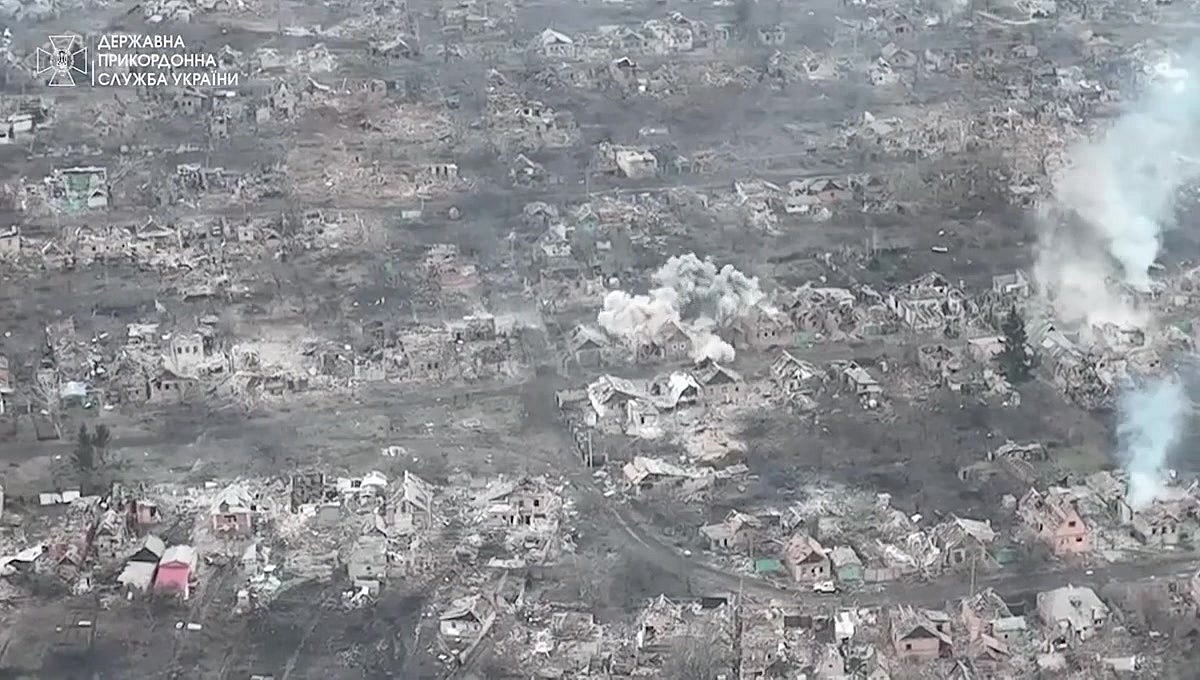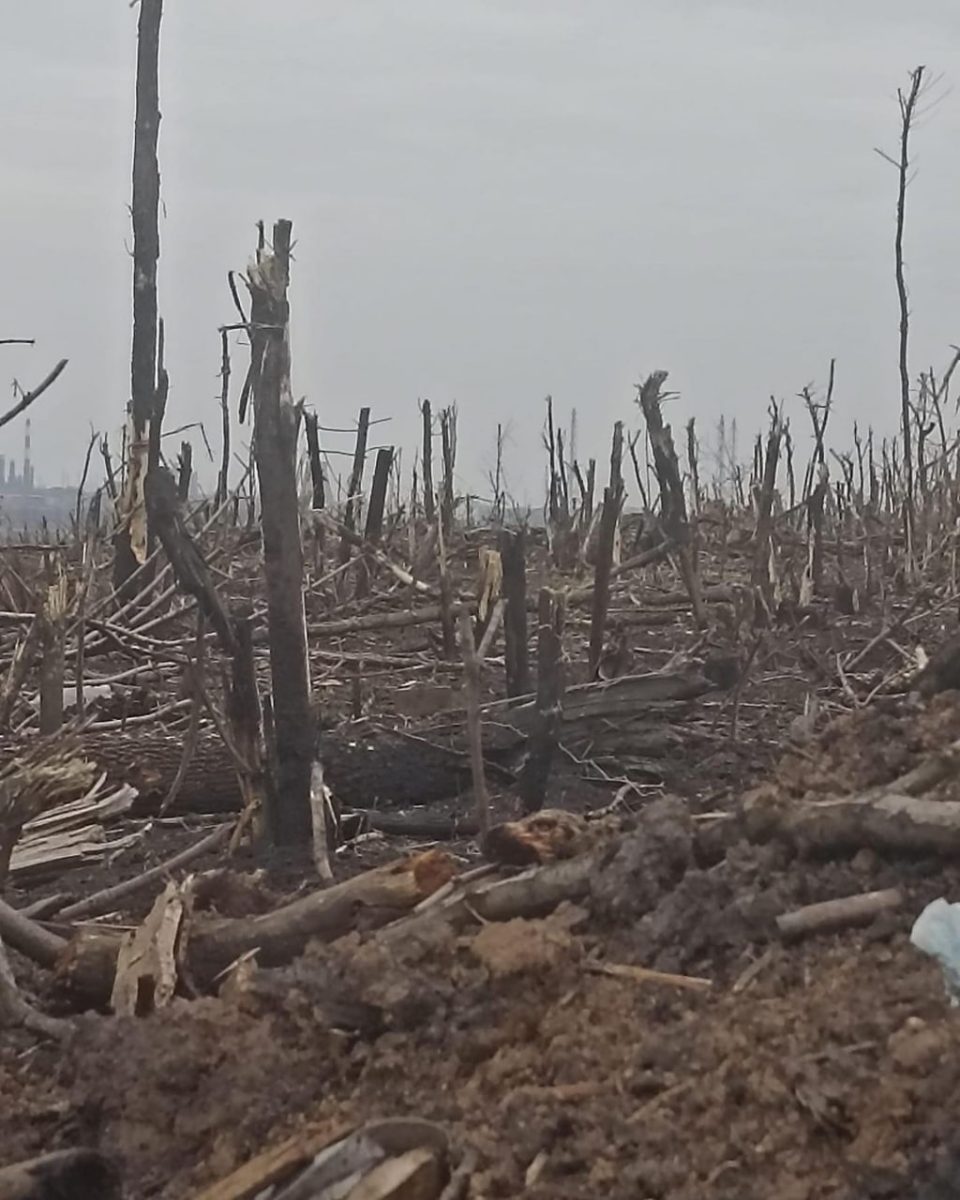The Fall of Bakhmut: How Was This Stronghold of a City Captured by Russian Forces?
After a valiant and prolonged defense, the Ukrainian city of Bakhmut was captured by invading Russian forces.
Here is a photograph of the city of Bakhmut, located in the Donetsk region of Ukraine, during the battle over the city. (Photo Credit: Dpsu.gov.ua, CC BY 4.0
Standing on the crumbling outskirts of western Bakhmut, Yevgeny Prigozhin, CEO of the Russian “Wagner” private mercenary company, addressed the Russian people. “Today we took Bakhmut. Starting on the 25th we will be taking the units out for rest and retraining. We’ve been fighting for 427 days from May 19th of last year, when (the) Motherland needed our help. We took the whole city… no one can meticulously reproach us that some piece wasn’t taken.”
From the eyes of a drone, the city Bakhmut seethes below. White and gray smoke rises from the apartment blocks. Every building has been relentlessly shelled and bombed. Rubble covers the street, littered with blown up vehicles. The surrounding suburbs have been almost completely obliterated, with trenches lining the surrounding fields.
This city within the Donetsk Oblast region of Ukraine once sported a population of over 70,000. During its Soviet-era, Bakhmut was called Artemivsk. During the 2014 Donbas conflict, pro-Russian militias and the Ukrainian government fought each other for control over the then Artemivsk, with the Ukrainians eventually recapturing it. In 2016, in an effort to disassociate from Soviet influences, the Ukrainian government renamed the city to its pre-soviet name, ‘Bakhmut.’
The city now lies in Russian hands, with units of the Russian Armed Forces (RAF) that have moved in to secure the territory. But how did this stronghold of a city fall? One of the main objectives of Russia’s invasion of Ukraine was to capture the entirety of the Donbas region. The Donbas region comprises two large pieces of Ukrainian speaking land, including the Donetsk and Luhansk Oblasts. Russian forces pushed into the Donbas, seeking to encircle Ukrainian defenders and entrap them. Despite a valiant defensive front, the Ukrainian Armed Forces (UAF) lost the city of Popasna, east of Bakhmut. Later, the UAF suffered further territorial losses, as the battles of Severodonetsk and Lysychansk resulted in the entirety of Luhansk Oblast being captured by the Russians. They then pivoted for Bakhmut.
The battle itself began in early August of 2022, as Russian forces began to increase their artillery bombardment of the city and its defenses. Wagner PMC then began their ground attack on the city, pushing towards the southeast areas of the city. Russian forces followed suit, capturing territory further south of the city.
Winter
Fighting conditions worsened into the winter of 2022-2023, as the main Russian offensive’s momentum died out. The battle turned to trench warfare, as both Russian and Ukrainian troops dug in for the prolonged battle. Artillery raged on, inflicting hundreds of casualties. Drones with grenades attached to them were utilized to target those huddled in the trenches. The trenches themselves were disgusting. Garbage was scattered everywhere. In the areas where combat was heaviest, bodies lay uncollected, rotting in the trenches. Despite the raised defenses surrounding the city, Wagner PMC would continue to attack the city, their influence in the war becoming more prominent.
It’s here that mainstream media would popularize Wagner’s “human wave tactics” against dug-in Ukrainian defenders. However, the description tends to be misconceived in the minds of many readers. Again, Bakhmut is not identical to a World War 1 battle; there are only similar conditions in which the battle was fought. The “human wave” tactic refers to the relentlessness of Wagner PMC skirmishes and attacks, rather than massive amounts of people pouring out of a trench. These small squads of soldiers can repeatedly attempt to pierce or wear down any weak point in the Ukrainian defensive line. As Wagner CEO Yevgeny Prigozhin has pointed out, though casualty rates are extremely high, they utilize mainly “expendable” soldiers, such as convicts, in order to wear down UAF defenders.
On the 13th of December, intense street fighting erupted from within the city itself as Russian and Wagner forces entered the city borders. Fighting in the urban areas from the east and southeast broke out, while further attacks from the north of the city were repelled by the UAF, who were located in the neighboring city of Soledar.
But, by January 2023, the city of Soledar had completely fallen to Russian forces, hastening the encirclement of Bakhmut. At this point in the battle, RAF and Wagner forces were closing in from the North, East, and South of Bakhmut. The Ukrainian forces garrisoned in Bakhmut began to consider an orderly withdrawal from the area, as roads and bridges were sabotaged behind them to delay Russian advances.
Video Caption: Here is a look at the intense urban warfare from within Bakhmut. Ukrainian defenders fire rocket propelled grenades at Russian positions, just across the street.
The heavy street fighting raged on. And on March 26th, 2023, Yevgeny Prigozhin published a video of Wagner forces occupying the town hall of Bakhmut, seeking a legal claim to the city, boasting Wagner’s progress. At this point, 80% of Bakhmut had fallen to the invading forces.
Ukraine’s final grasp of the city started to slip in May 2023. Intense fighting within the city continued to cause mass attritional losses for both sides. To deal with this, on May 9th the Ukrainian Armed Forces began to conduct counter-offensives around Bakhmut, such as in Khromove (a rural area west of Bakhmut) and in Bila Hora (a village 14km to the southwest of Bakhmut). These counter-offensives were limited and saw marginal success.
During these counter offensives, the UAF encountered the unsupported Russian 72nd Separate Motorized Rifle Brigade, allegedly destroying two companies (a significant amount) of the brigade, and advancing 3 kilometers along the flanks of Bakhmut. But the 72nd Brigade should not have been alone, with units of the Russian Wagner PMC supposedly posted adjacent to the 72nd.
The Ukrainian victory here wasn’t just a battle won, it represented a bigger issue that Russian units faced in battle – an inability to effectively communicate with each other. In an interview conducted by Russian journalist Anastasia Kashevarova, a Wagner PMC officer witnessed a fatal miscommunication between the 72nd Brigade of the Russian Army, and the PMC. According to him, the Wagner units “withdrew from that flank because they had a breakthrough elsewhere, and the 72nd Brigade did not know this.” Without receiving any warning that their protection had withdrawn, the 72nd was left unprepared to deal with the Ukrainian advances. With only artillery stationed in the area, and insufficient infantry support, the 72nd quickly fell apart. The officer complains that the squabbles and miscommunications are not rare. The Wagner Officer continues, “The military police squeeze out humanitarian aid, customs does not let drones through. By the way, the DPR and LPR battalions are also at odds with each other. All against all.”
The internal Russian squabbles were intensified by the Ministry of Defense (MoD) and Yevgeny Prigozhin, CEO of the Wagner PMC. As the battle in Bakhmut raged on, Wagner continued to suffer surmounting casualties. Though regular Russian forces took on some of the fighting on the flanks and surrounding areas of the city, Wagner was not receiving the help it was actually asking for. After months of fighting and many ignored requests, Prigozhin publicly called out the MoD for not providing Wagner forces with the adequate ammunition it was promised. In a video publication released by Prigozyn’s press service the CEO, surrounded by the bodies of his mercenaries, cried “…listen to me. These are someone’s fathers, and someone’s sons.”
Soon after, Prigozhin made sure to clarify in all publications that his grievances were with those in the Ministry of Defense, and not with Putin directly. Prigozhin sought to maintain strong affiliations and good favor with Putin, in order to maintain political influence.
Video Caption: This video was taken on May 5th, 2023. In it, Ukrainian defenders show the bombed out ruins of the city.
By May 16th, 2023, Ukrainian localized counter-attacks continued, while Russia shored up its defenses. The VDV, having been rebuilt after devastating casualties in the earlier stages of the war, had remobilized and returned to the front, now tasked with defending Russian gains on the flanks of Bakhmut. The goal of the UAF at this point in the battle seemed to be to tire out Russian defenses. The Russians sought to do the same, to drain Ukrainian defenders in a condensed battle, but additional objectives such as capturing the important highway T0504 also occupied the minds of the attackers. Capturing this would give the Russians access to various populated Ukrainian cities.
Capture and Withdrawal
By May 21st, 2023, the UAF could no longer hold onto Bakhmut. Wagner forces secured the western legal borders of the city, declaring victory. Though Ukrainian counter attacks continued from around the flanks of the city, Putin and Prigozhin claimed the battle won. Ukrainian forces withdrew from the city, but maintained control of the important highways leading into Bakhmut.
But who could claim victory? Vladimir Putin himself attributed the victory in Bakhmut to Wagner PMC, while acknowledging “support” from Russian armed forces in the form of air support and artillery. Prigozhin, rejected the idea that regular Russian forces played any significant role in the capture of the city. By doing this, he leverages Wagner’s acclaimed importance in the war against Ukraine, in order to secure supplies and ammunition not previously granted to him.
However, according to Prigozhin, 16,000 mercenaries were killed while capturing Bakhmut. The battle was so draining that many believed Bakhmut to be the culmination of offensive operations for quite some time. In order to recover and retrain their ranks, the PMC will most likely have to withdraw to safer regions behind friendly lines. Russian regular forces will most likely occupy the defensive positions left by Wagner, to repel the Ukrainian counter attacks.
Video Caption: The city of Bakhmut as of May 31, 2023.
Bakhmut was one of the deadliest battles of the war so far. Western countries estimates put Russian and Wagner casualties at 60,000, while Wagner PMC claims 50,000 Ukrainian defenders killed in action. Tens of thousands of Ukrainian and Russian lives were lost to the war. The city itself, once a lively administration center, and essential to Donetsk Oblast, lies in complete obliteration. To the Ukrainians it was Bakhmut, to the Russians it was Artemivsk. Either way, now it’s an uninhabitable, shell scarred wasteland.
The city itself, once a lively administration center, and essential to Donetsk Oblast, lies in complete obliteration. To the Ukrainians it was Bakhmut, to the Russians it was Artemivsk. Either way, now it’s an uninhabitable, shell scarred wasteland.
Tristan Borlongan is a Spotlight Section Editor for 'The Science Survey.' As a journalist, Tristan has a curiosity for international conflict and geopolitics....












